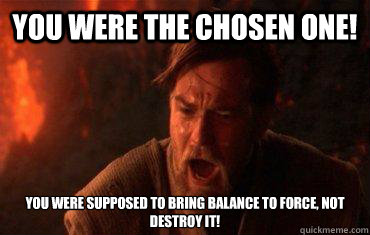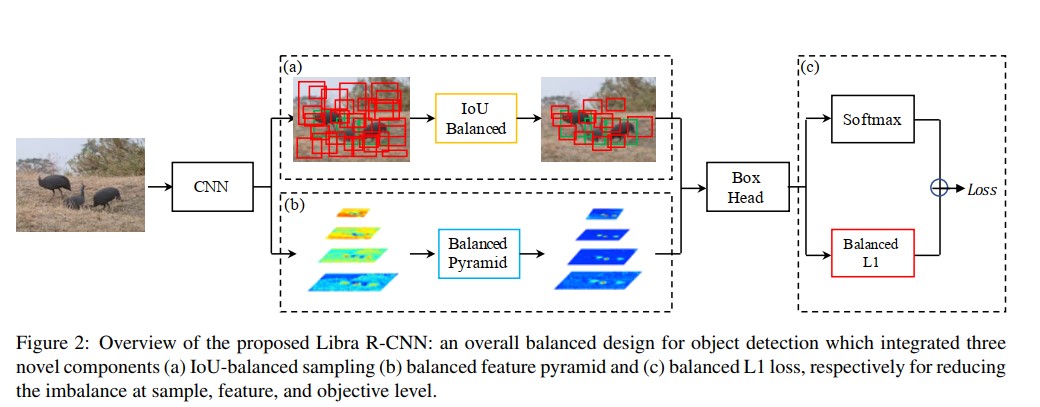Regarding the object detection problem, it seems like the community pays less attention to training pipeline than other tasks such as network design, inference improvement. This paper investigates the current problem of the CNN detection models. They consider the imbalance phenomenon, which is composed of 3 levels:
- Sample level.
- Feature level.
- Objective level.
They basically are 3 corresponding major components of a detection model: feature extraction, region proposals, and predictors. Based on such categorization, they propose the following improvements:
- IoU-balanced sampling.
- Balanced feature pyramid.
- Balanced L1 loss.
So, everything is balanced now.

The authors draw a pretty nice figure to demonstrate their points.

Review and Analysis

Now, let take a look at 3 aspects of imbalance training from the point of view of this paper.
Sample level Imbalance
There are many circumstances in which the training data, especially the easy samples, becomes imbalance:
-
Data distribution: it becomes severe if the training data is bias to certain viewpoints, pose or object shape. The model needs to focus on the hard positive samples in order to gain more gradient, and thus it is able to learn and generalize. Otherwise, it keeps learning from easy samples, which make the gradient is almost 0. These cases are considered as hard positives, which is not examined in this paper.
-
Data sampling: two-stage detectors use data sampling in order to train the model. Even though the number of images is small (2 or 4) and the number of grouthtruth is also relatively small. Considering the COCO dataset, even though we have 80 labels, not all of the images has a large number of boxes. Meanwhile, the sampler usually generates thousands of regions, hence the easy negative samples dominate the whole set.
-
This is the well-known problem in object detection, hence many papers tried to tackle this problem. There are 2 methods worth mentioning:
-
OHEM: Instead of freezing the network, computing the hard negative examples, adding them to the training set and continuing training the model, OHEM directly computes all the ROIs in a batch and selects the hard negatives from them.
-
Focal loss takes a whole different approach. It reshapes the standard cross entropy loss such that it down-weights the loss assigned to well-classified examples. The authors argue that Focal Loss shows little improvement in R-CNN. It may be true, I only tested this loss on one-stage detection models. However, Yolov3’s authors also mentioned Focal Loss does not work well on their model.
-
Feature level imbalance
This quote is interesting when they talk about FPN and PANet - region proposal methods that use multi-scale feature mapping:
The methods inspire us that the low-level and high-level information are complementary for object detection. The approach that how they are utilized to integrate the pyramidal representations determines the detection performance. … Our study reveals that the integrated features should possess balanced information from each resolution. But the sequential manner in the aforementioned methods will make integrated feature focus more on adjacent resolution but less on others. The semantic information contained in non-adjacent levels would be diluted once per fusion during the information flow.
This section of the paper is quite weak and not convincing. They do not mention any experiments to justify their arguments. In addition, they said they inspired from the aforementioned methods but did not elaborate on how they come up with the proposed method.
Objective level imbalance
Nowadays, a typical object detection model carries two tasks: label classification and box regression. Depend on the difficulty and the distribution of training data, the ultimate objective may not be integrated well from two separate losses. For example, the box regression is compromised, hence it leads to the high performance on box results but poor on concept results.
Imbalance easy-hard samples also affect the gradient of the model. If the easy samples make up the majority of the batch, the gradient is dominated by the hard examples and thus the model learns nothing from the easy samples. Despite being called “easy samples”, it does not mean that there is nothing to learn from the easy samples. The reason is that once the model is able to spot the “easy” feature in the image, it discards the remaining visual features remaining in the image. In other words, it only looks at some particular position/feature in the image which makes it easy to learn.
In my opinion, sample imbalance and feature imbalance are the most important aspects we have to deal with. It seems like CNN can learn different viewpoints as long as we provide proper training data. Nonetheless, we can not feed a huge amount of data of every object of every single angle. Secondly, the annotation quality dramatically changes because of the quality, characteristic of the image. For example, stock images, product images get clear, accurate bounding box label. Photos that are taken from smartphones, random images on Internet, on the other hand, are completely different stories. By looking at the annotation of COCO dataset, you know what I mean.
Proposed Methods
IoU-balanced Sampling
I really don’t understand Figure 3 in the paper. What is the setting of the experiment? How do they identify the overlap between the sample and its corresponding ground truth?

Turn out the figure is not difficult to interpret. The IoU in the figure means the overlap between the ground truths and the generated regions from samplers. So, the experiment points out that hard samples has higher IoU with the ground truths than that of random samples. Therefore, the authors propose a new sampling scheme that conforms with the IoU distribution of hard examples.
Balanced Feature Pyramid

Balance Feature Proposals
The algorithm for this method is described as the following:
1. [Rescaling]: Resize all feature map into 1 size (intermediate size) using interpolation and max-pooling.
2. [Integrating]: Sum all rescaled feature and normalize it.
3. [Refining]: Directly use convolutions or use non-local module such as Gaussian non-local attention.
4. [Strengthening]: Rescale the obtained feature to the original resolutions.
We can interpret those steps as applying a Pooling layer to form high-level feature, which resembles the final pooling of image retrieval. Hence, it means to improve the abstract level of the feature.
Balanced L1 Loss
The whole formulation of the loss can be seen in the paper. In summary, the authors want to: (1) cap the gradient of the box regression in order to balance with the classification gradient and (2) improve the gradient of the easy samples.
Experiment results
From the result of ablation experiments in Table 2, there is some interesting stuff I have observed:
- In general, combining 3 methods dramatically improves the average precision of large objects. However, there is not much effect shown in the small objects. In my opinion, small objects still are the most difficult aspect to improve detection models.
- IoU balanced Sampling and Balanced L1 Loss clearly help to improve the Average Precision at IoU=0.75. It means they produce boxes closer to the ground truth.
- The same trend also can be seen on RetinaNet in which the authors only two methods (Balanced Feature Pyramid and Balanced L1 Loss). Again, the proposed methods improve the overall performance with quite a large margin (+5%), especially on the large objects.
Implementation
In the next two weeks, I will implement the balanced feature pyramid and the balanced L1 loss. I am not sure if I have time for IoU sampler since my focus is on RetinaNet which naturally does not use sampler (but we can trick it a bit and utilize the component). Even though the authors have already released source code using Pytorch, I have to rewrite the whole things through caffe2 and Detectron. It may take a while.
Weighted Component Loss
In couple of experiments, I have found that there is a big gap betwwen box precision and concept precision. So, my hypothesis is that the box regression loss actually dominates the whole loss of the model. From the that, I halve the weight of the box regression and train the model. Here is the results:
| Model | Concept Recall | Concept Precision |
|---|---|---|
| resnet_36_tiny12_v0800 (baseline, size 256) | 0.4000 | 0.4445 |
| resnet36_tiny15_v0900 | 0.4122 (+3.05%) | 0.4685 (+5.40%) |
| resnet36_tiny14_v0800 (baseline, size 320) | 0.4194 | 0.4651 |
| resnet36_tiny16_v0800 | 0.3906 (-6.8%) | 0.4984 (+7.16) |
tiny12 and tiny15 are basically the same except tiny15 uses smaller loss weight for box regression (0.5 insteadof 1.0). The same settings are applied for tiny14 and tiny16, respectively. From the result, we can see by balancing the loss component, even with the naive approach, it indeed helps the overall performance. However, the second setting is difficult to observe the performance gain. I better use the mAP instead.